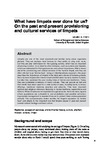What have limpets ever done for us? On the past and present provisioning and cultural services of limpets
| dc.contributor.author | Firth, Louise | |
| dc.date.accessioned | 2022-01-20T10:17:42Z | |
| dc.date.available | 2022-01-20T10:17:42Z | |
| dc.date.issued | 2021-11-23 | |
| dc.identifier.issn | 2205-3204 | |
| dc.identifier.issn | 2205-3212 | |
| dc.identifier.uri | http://hdl.handle.net/10026.1/18588 | |
| dc.description.abstract |
Limpets are one of the most abundant and familiar rocky shore organisms globally. They are perhaps most famous for their ability to cling onto rocks, but they are also well known for their grazing activity, which has an important structuring function. In contrast to other molluscs, such as oysters and mussels, which are celebrated for their gastronomic and cultural importance, little is known about the provisioning and cultural services of the humble limpet, and they are often referred to as 'famine food'. Using an interdisciplinary approach, this paper describes the importance of limpets in the diets and cultures of humans globally. Not only were limpets often the dominant shellfish eaten by early modern humans, but also they sustained the poor during times of famine and destitution. Today, they are considered a delicacy in many cultures. They are popular as bait and their shells have been used for a wide variety of uses, including tools, currency, offerings, traditional medicine, jewellery and artworks. They have important spiritual and religious relevance, featuring in myriad traditions, superstitions and folklore. Whilst limpets are not exploited on a global scale, there are many regions where populations are vulnerable to over-exploitation and possible extinction. Appropriate management is required if we are to protect these underappreciated animals. This comprehensive review rectifies the limpet's reputation as 'famine food' and attests to the important role that limpets played in past and present coastal cultural heritage and food culture. | |
| dc.format.extent | 5-45 | |
| dc.language.iso | en | |
| dc.publisher | ANU Press | |
| dc.title | What have limpets ever done for us? On the past and present provisioning and cultural services of limpets | |
| dc.type | journal-article | |
| dc.type | Journal Article | |
| plymouth.issue | 2 | |
| plymouth.volume | 7 | |
| plymouth.publication-status | Published | |
| plymouth.journal | International Review of Environmental History | |
| dc.identifier.doi | 10.22459/ireh.07.02.2021.01 | |
| plymouth.organisational-group | /Plymouth | |
| plymouth.organisational-group | /Plymouth/Faculty of Science and Engineering | |
| plymouth.organisational-group | /Plymouth/Faculty of Science and Engineering/School of Biological and Marine Sciences | |
| plymouth.organisational-group | /Plymouth/REF 2021 Researchers by UoA | |
| plymouth.organisational-group | /Plymouth/REF 2021 Researchers by UoA/UoA07 Earth Systems and Environmental Sciences | |
| plymouth.organisational-group | /Plymouth/Users by role | |
| plymouth.organisational-group | /Plymouth/Users by role/Academics | |
| dcterms.dateAccepted | 2020-07-17 | |
| dc.rights.embargodate | 2022-1-26 | |
| dc.identifier.eissn | 2205-3212 | |
| dc.rights.embargoperiod | Not known | |
| rioxxterms.versionofrecord | 10.22459/ireh.07.02.2021.01 | |
| rioxxterms.licenseref.uri | http://www.rioxx.net/licenses/all-rights-reserved | |
| rioxxterms.licenseref.startdate | 2021-11-23 | |
| rioxxterms.type | Journal Article/Review |


